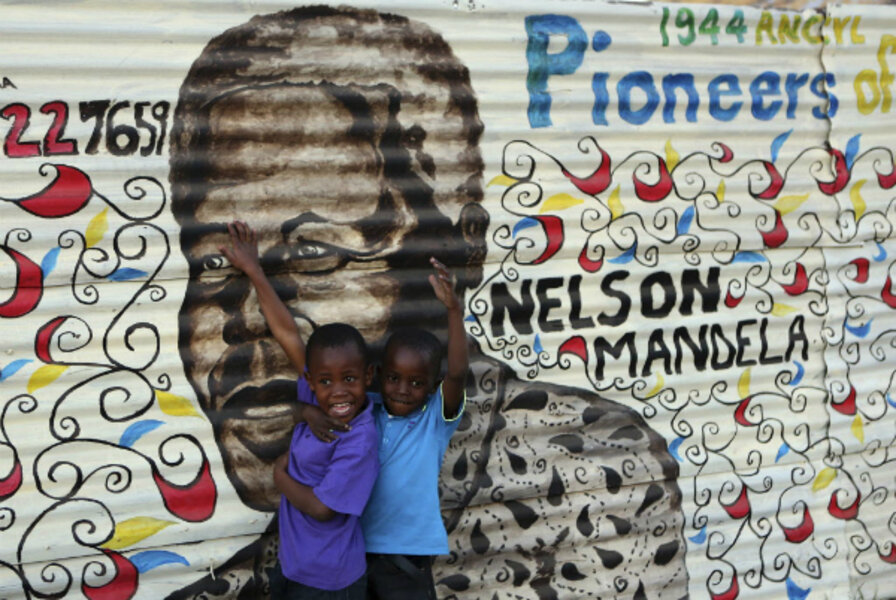Nelson Mandela: What South Africans couldn't tell their kids about him
As parents, we transmit the qualities – and myths – of our leaders through the stories we tell our children. Think George Washington and his cherry tree, Abraham Lincoln and his Gettysburg Address, Martin Luther King and his “I Have A Dream” speech, delivered at the foot of the Lincoln Memorial.
But what if we not only did not pass on those tales to the next generation, but actively worked to suppress them? Surprisingly, that is what happened in the case of Nelson Mandela, the anti-apartheid revolutionary and former president of South Africa, who died Dec. 5. That he was nonetheless able to seize the imagination of hundreds of thousands of young South Africans and inspire them to rise up against apartheid’s unspeakable oppression is yet another tribute to what was his last-of-a-kind leadership.
QUIZ: Father of the Rainbow Nation – How well do you know Nelson Mandela?
The details of Mr. Mandela's imprisonment are well known. In July 1963, South African police raided the secret headquarters of the armed wing of the African National Congress at a farm outside of Johannesburg, arresting most of its leaders. Eight of them, including Nelson Mandela, were sentenced to life in prison on Robben Island, a desolate stretch of rock off the coast of Cape Town. The raid effectively stilled black opposition for a decade. What remained of the ANC was forced to regroup outside the country, far from South Africa’s borders. An entire generation of black activists was imprisoned, banned, or exiled. To deter resurgence of political movements, the police assumed unbridled powers of arrest and detention and recruited an army of black informers; the government imposed harsh restrictions on the press.
The measures left blacks utterly intimidated. People shunned political discussions; to speak of such matters was to invite repression. The ANC’s protest campaigns of the 1950s, the creation of its Freedom Charter, the stories of its leaders – all slipped into obscurity, suppressed by parents too frightened to tell their children. Newspapers could not even print Mr. Mandela’s photograph.
A young man recounted to me a remarkable example of this parental attempt to protect their children when I was working as The Christian Science Monitor's South Africa correspondent in the late 1980s. One day when he was a little boy, he asked his father about graffiti he had seen spray-painted on an electrical sub-station on his way home from school in the sprawling black township of Soweto. “Who is Mandela?” he inquired. His father instantly slapped him across the face; in a choked voice, he ordered his son never to utter the name again and stalked out of the room.
To an outsider, the anecdote was startling on several levels: the young man’s ignorance, as a boy, of Mandela; his father’s visceral response to the ANC leader’s name; the seeming success of the white-minority government to gag an entire generation of black parents. But perhaps even more astonishing was that when the young man told me the story 15 years after the fact, Mandela had become an iconic presence in every township across South Africa.
For although the government succeeded in obstructing the usual imparting of political lore from parent to child, those stories – like most universal truths – found another conduit. Here is how it happened: The mid-1970s saw the rise of a new anti-apartheid movement, Black Consciousness (which generally rejected the ANC’s non-racial and inclusive philosophies), and other leaders, most notably Steven Biko. Influenced by the movement, high school students in Soweto led a massive protest march on June 16, 1976, against the imposition of Afrikaans as the language of instruction. Their parents knew nothing of the planned demonstration. The police responded with violence; the protest turned into rioting that raged for months.
The government ultimately stamped out the unrest through brutally repressive measures that included arresting hundreds of the student organizers, putting them on trial and sending them to be imprisoned on Robben Island. There they met Mandela and his cohorts. It was nothing short of an epiphany for the youngsters: the ANC leaders organized stealthy study sessions, away from the prying eyes of their wardens, in which they taught the ANC’s philosophy and history and the roles they had played in earlier demonstrations and protests. One such student told me he used to feel practically dizzy with all that his elders had to impart.
For the first time ever, the young people learned about how the previous generation had been involved in the anti-apartheid struggle. (Which earned the Robben Island prison the sobriquet of “The University” among activists.) So that when the youngsters were released from the jail in the early- to-mid- 1980s, they returned to the townships as fervent ANC converts, eager to spread the stories of the organization and of Mandela. Their activism, among others, spawned another spasm of violent protests that ultimately led to Mandela’s release in early 1990, and to the country’s first democratic elections four years later in which Mandela was elected president.
It is thus one of the great ironies of South African history that where most parents had failed, the apartheid government unwittingly succeeded in elevating Mandela to the very status it had so cruelly sought to suppress.






